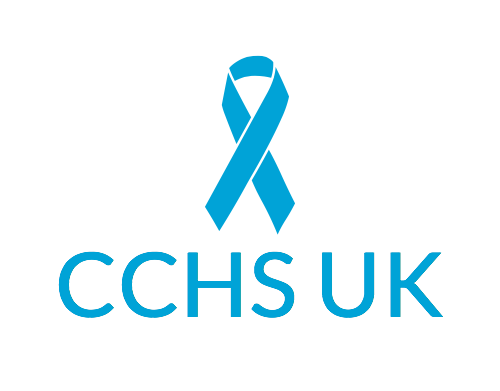When sleep is deadly
There is an amazing community of over 100 families in the UK who will support you and your loved ones on your CCHS journey. Although the condition is incredibly rare – with only 1,200 known cases worldwide – there are babies, toddlers, children, teenagers and adults who have been diagnosed and are living full and rich lives.
Explore Advice and Info
Please click on the links below to explore all kinds of answers to useful questions relating to CCHS.
What is CCHS
CCHS is short for Congenital Central Hypoventilation Syndrome. It’s a genetic condition affecting the automatic control of breathing. Breathing should happen automatically – without a person having to think about when to do it – however in CCHS, the normal safeguards used by the nervous system to control breathing don’t work as they should.
People with CCHS do not respond to increased carbon dioxide levels that would trigger a healthy person to draw a breath, which means breathing can stop. Most CCHS people mainly experience symptoms when asleep, but some can also stop breathing or under-breathe when awake – this may be particularly evident when eating (especially in infancy) or concentrating.
What causes CCHS?
In 2003, the PHOX2B gene was identified as the specific gene which causes CCHS. This gene is responsible for the development of the baby’s nerves in early pregnancy to form specific types of nerve cells, especially in the autonomic nervous system. As the nerve cells don’t work as they should, messages between the body and brain are not passed on correctly.
The mutation can sometimes be inherited, but 90 per cent of CCHS result from a random mutation of this gene.
How is CCHS Diagnosed?
The diagnosis of CCHS depends on documenting that under-breathing occurs during sleep, and that this is not due to a muscle or lung disease, or some other congenital syndrome (a different type of genetic disorder). Oxygen and carbon dioxide monitors can be used to show whether a person is breathing efficiently during sleep. Blood tests can also be used in a hospital setting.
The identification of the role of the PHOX2B gene in CCHS means that genetic testing of blood can confirm within a matter of weeks whether a person has the condition.
The condition can be scary, and at first, you’ll be dazed or overwhelmed. But in no time at all you will become an expert and you’ll start hearing (and using) words like…
- Ventilator – a machine that helps someone breathe if they can’t do it on their own
- Pulse Oximeter/‘Sats monitor’ – monitors blood oxygen levels
- CO2 monitor – monitors carbon dioxide levels
- Tracheostomy/‘trache’ – an opening created at the front of the neck so a tube can be inserted into the windpipe (trachea) to help someone breathe.
- Non-invasive ventilation – provides breaths through the upper airway using a mask
- Intubation – a tube inserted into a person’s nose or mouth to help them breathe
How is CCHS treated?
Children and adults need a ventilator to breathe for them. A ventilator blows air pressure through either:
- A tracheostomy
- A mask over the nose or face
Another option is phrenic nerve pacing – a battery powered system which electrically stimulates a person’s diaphragm muscles and nerves. The pacing causes the diaphragm to contract so that air is pulled into the lungs.
There are mixed reports from CCHS patients globally – some people have found the operation to be life-changing, others haven’t had the same success and have reverted back to a mechanical ventilator. The procedure isn’t currently available on the NHS, but UK CCHS expert Dr Martin Samuels is working with CCHS UK to progress this in 2023.
People with CCHS need to be continuously monitored, especially in early childhood when little ones sleep a lot! Oxygen monitoring must be used during sleep and many children also have their carbon dioxide levels monitored.
What will home life be like?
It’s normal to feel anxious about what’s ahead, but the CCHS family network will provide a huge amount of support when you’re adjusting to a new life at home with medical equipment and carers. There are families who’ve been there and have plenty of advice to ease the transition from hospital to home. There is a dedicated Facebook group where many families ask questions, share concerns or connect with others living with the condition.
Most families have carers to look after their children overnight – which can take some getting used to – but you’ll soon adapt. It can be strange to have someone in your home at first, but like everything with CCHS, it quickly becomes the norm.
To get home from hospital quickly, you’ll want to start thinking about:
• Any house alterations eg. extra sockets
• Shelving units for medical equipment
• Storage for supplies eg. boxes, repurposing cupboards/drawers
• Space for a carer to sit comfortably for 7/8 hours while you sleep
As children grow, their need for ventilation may change so they’ll be called to take part in regular sleep studies. The condition appears to be life long and no patient with CCHS has been documented to outgrow the disorder. Despite this, many children do brilliantly well – they may attend a mainstream school and have a normal lifestyle while awake. Some of the photos show what people with CCHS can do – skiing, running, cycling, swimming and even skydiving!
What other problems are common with CCHS?
The gene that causes CCHS is associated with the development of the autonomic nervous system, which controls heart rate, digestion, body temperature and blood pressure.
In 15 per cent of cases, people with CCHS might also develop Hirschsprung’s Disease, which affects the bowel and is related to the underdevelopment of the nerves in the gut. This can lead to constipation and bowel obstruction and sometimes requires surgery.
Some people may have a problem affecting their heart rhythm and require a pacemaker. This involves episodes in which the normal heart rhythm stops for a few seconds. It may present with episodes of dizziness or collapse. CCHS people should have their heart rhythm checked (ECG and Holter monitoring) throughout their lives.
Some children may have problems with the way the brain develops after birth – these may not show up in early infancy, but become more apparent as the child grows.
People with CCHS may also have difficulty swallowing, they may struggle to regulate their temperature (either too hot or too cold) and can be prone to eye problems.
Rarely, abnormal growths of nerve cells develop alongside the spine (ganglioneuromas and neuroblastomas), which if found to be malignant need surgical removal and treatment.
What research is going on?
As with most conditions that are very rare, there is little funding available for research. However, in 2009, a pan-European group, including researchers from France, Germany, Italy, Poland, Sweden and the UK, was successful in obtaining an EU grant to learn more about the condition and its management.
There are now 14 collaborating countries, and the health professionals have:
• established a registry of individuals affected by the condition
• developed clinical guidelines for the treatment of CCHS
• produced information for patients and their families
• set up a website for use by families and professionals, and
• learnt more about how the condition is managed by different centres across Europe
The CCHS Family Network in the US organises a twice- yearly research update for CCHS experts around the world to improve our understanding and treatment of this rare condition.


